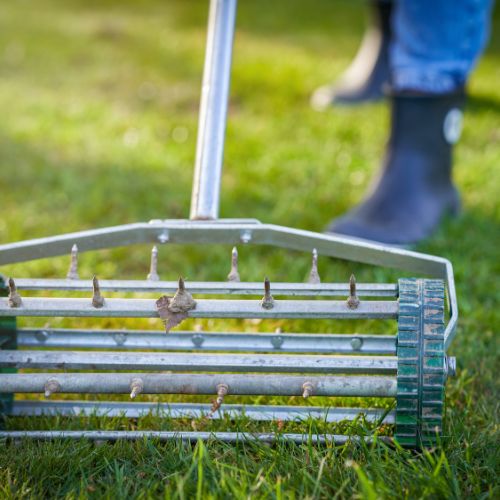Maintaining a lush, healthy lawn requires more than regular mowing and watering. One often overlooked aspect of lawn care is aeration, a process that can significantly impact the health and appearance of your grass. So, are you wondering what aeration is? In this comprehensive guide, we’ll delve into the intricacies of lawn aeration, exploring its various types, benefits, and best practices to help you achieve the greenest lawn on the block. Let’s dive in!
1. Understanding Your Soil
Lawn aeration is the key to unlocking your lawn’s full potential, allowing it to thrive in even the harshest conditions. Let’s explore the fundamentals of lawn aeration, including what it is, how it works, and why it’s essential for maintaining a beautiful lawn.
What Is Lawn Aeration?
What is lawn aeration? Lawn aeration is the process of perforating the soil with small holes to allow air, water, and nutrients to penetrate deeply into the grassroots. Over time, the soil underneath lawns can become compacted due to foot traffic, heavy machinery, or natural processes. Aeration helps alleviate this compaction, promoting healthier grass growth.
How Does Lawn Aeration Work?
During aeration, plugs of soil are removed from the ground, creating channels that allow air, water, and nutrients to reach the grassroots more effectively. This process enhances soil structure, encourages root development, and improves turf health.
Importance of Soil Aeration for Grass Health
Soil aeration is crucial for maintaining a lush and vibrant lawn. Compacted soil restricts root growth and prevents proper absorption of essential nutrients, leading to thinning grass, water runoff, and increased susceptibility to pests and diseases. By aerating the lawn soil, you can revitalize your lawn, promoting stronger roots and denser turf.
Types of Lawn Aeration
Choosing the right types of aeration for your lawn is crucial for achieving optimal results. Each method offers unique benefits and considerations, from core aeration to spike aeration. Let’s delve into the world of lawn aeration methods to help you make informed decisions about different types of aeration for your lawn care regimen.
Core Aeration
Core aeration involves using a specialized machine to remove small plugs of soil from the lawn. These plugs, or cores, are typically 2-3 inches long and 0.5-0.75 inches in diameter. The spacing between the holes depends on the severity of soil compaction and the type of aeration.
Pros and Cons of Core Aeration
-
Pros:
- Relieves soil compaction effectively.
- Promotes better air, water, and nutrient infiltration.
- Stimulates root growth and improves overall turf density.
Cons:
- May leave unsightly plugs on the lawn temporarily.
- Requires specialized equipment.
- More labor-intensive compared to spike aeration.
Equipment Needed for Core Aeration
- Core aerator machine
- Lawn mower (optional, for collecting cores)
Best Times for Core Aeration
When is the best time to aerate your lawn? Warm season grasses like Bermuda grass benefit from aeration in late spring or early summer, while cool-season grasses such as fescue or bluegrass benefit from aeration in early fall.
Spike Aeration
Spike aeration involves puncturing the soil with solid tines or spikes to create holes without removing soil cores. While less invasive than core aeration, spike aeration may not be as effective in relieving soil compaction.

Pros and Cons of Spike Aeration
Pros:
- Quick and easy process.
- Requires less specialized equipment.
- Can be done more frequently without causing as much stress to the lawn.
Cons:
- Less effective in relieving soil compaction compared to core aeration.
- May further compact the soil around the spike holes.
- Does not address thatch buildup or promote deep root growth as effectively as core aeration.
Equipment Needed for Spike Aeration
- Spike aerator machine or manual spike aerator shoes
Situations Where Spike Aeration May Be Appropriate
Spike aeration can be suitable for lightly compacted soils or supplemental aeration between core aeration sessions. It’s also a practical option for homeowners who prefer a less disruptive approach to lawn care.
Benefits of Lawn Aeration
Lawn aeration offers many benefits that contribute to your turf’s overall health and vitality. By understanding these advantages, you can appreciate the importance of incorporating the aeration of lawns into your lawn care routine.
Improved Soil Drainage
Aerating your lawn creates channels in the soil, allowing excess water to drain more efficiently. This prevents waterlogging, which can lead to root rot and other issues. Improved soil drainage ensures water reaches the grassroots effectively, promoting healthy growth and reducing the risk of water-related damage.
Enhanced Nutrient Uptake
Aerated soil facilitates better nutrient absorption by the grassroots. As air, water, and nutrients penetrate deeper into the soil, they become more accessible to the roots, fueling robust growth and vibrant greenery. Enhanced nutrient uptake results in stronger, more resilient grass that can better withstand environmental stressors.
Reduction of Soil Compaction
Over time, soil compaction can restrict root growth and impede the flow of air, water, and nutrients. Aeration of lawns alleviates soil compaction by loosening the soil and creating space for roots to expand. So you should know what is aeration of lawns? This allows grassroots to penetrate deeper into the soil, establishing a stronger foundation for your lawn and promoting overall turf health.
Promotion of Healthy Root Growth
Healthy roots are essential for maintaining a thriving lawn. Aeration stimulates root growth by providing roots with the oxygen, water, and nutrients they need to flourish. Stronger root systems anchor grass more securely in the soil, making it more resilient to drought, disease, and other stressors. Promoting healthy root growth ultimately leads to a lush, resilient lawn that stands the test of time.
Better Overall Lawn Health and Appearance
By addressing soil compaction, improving soil drainage, and promoting healthy root growth, lawn aeration contributes to better overall lawn health and appearance. A well-aerated lawn is denser, greener, and more resistant to weeds, pests, and diseases. With regular aeration, you can enjoy a vibrant, picture-perfect lawn that enhances the beauty of your outdoor space.
When to Aerate Your Lawn
When to aerate lawn? Determining the optimal time to aerate your lawn is essential for maximizing the benefits of the process. Several factors influence the timing of lawn aeration, including seasonal variations and the specific needs of your grass. Let’s dive in!
Factors Influencing the Timing of Lawn Aeration
The timing of lawn aeration depends on various factors, including the type of grass, soil condition, and climate. Here are some key considerations to keep in mind:
- Grass Type: Types of grass such as Warm-season grasses like Bermuda grass and Zoysia grass benefit from aeration in late spring or early summer, while cool-season grasses such as Kentucky bluegrass and fescue thrive when aerated in the fall.
- Soil Condition: If your soil is compacted or waterlogged, it may be beneficial to aerate regardless of the season. Pay attention to the condition of your soil and aerate as needed to improve its health.
- Climate: Consider the climate in your region when scheduling lawn aeration. Avoid aerating lawns during periods of extreme heat or drought, as this can stress the grass and impede recovery.
Seasonal Considerations for Aeration
The timing of lawn aeration is closely tied to the seasons, with different grass types of aerators for lawns benefiting from aeration at specific times of the year. Here’s a seasonal breakdown:
- Spring: Spring is an ideal time to aerate warm-season grasses as they emerge from dormancy and begin active growth. Aeration in spring helps promote vigorous root development and prepares the lawn for the growing season ahead.
- Fall: For cool-season grasses, fall is the optimal time for aeration. Aerating in the fall allows the grass to recover from summer stress, encourages deep root growth, and prepares the lawn for winter dormancy.
Signs Indicating It’s the Right Time to Aerate Your Lawn
Several signs indicate that your lawn may benefit from aeration. Keep an eye out for the following indicators:
- Thatch Buildup: Excessive thatch accumulation can hinder water and nutrient absorption, indicating the need for aeration to break up the thatch layer and improve soil health.
- Compacted Soil: If your lawn experiences heavy foot traffic or shows signs of soil compaction, such as pooling water or sparse grass growth, it may be time to aerate to loosen the soil and promote better root development.
- Stagnant Growth: If your grass seems to be struggling to grow or appears yellowish and sparse, it may be a sign that the soil is not receiving adequate oxygen, nutrients, or water. Aeration can help revitalize the soil and stimulate healthy growth.
How to Aerate Your Lawn: Best Practices
How to aerate lawn? Proper aeration of lawn is essential for achieving optimal results and ensuring the long-term health of your lawn. From preparing your lawn for aeration to selecting the right method and performing the process, there are several key steps to follow. Let’s get started!
Preparing Your Lawn for Aeration
Before aerating your lawn, it’s essential to prepare the turf to ensure the best possible results. So, how do you aerate a lawn? Here are some steps to take:
Mowing Grass to the Correct Height
Start by mowing your lawn to the appropriate height for your grass type. Cutting the grass slightly shorter than usual can make it easier for the aerator to penetrate the soil and remove cores effectively.
Watering the Lawn Adequately
Water the lawn thoroughly a day or two before aeration to ensure that the soil is moist but not waterlogged. Avoid aerating dry, hard soil, as this can make the process less effective and potentially damage the grass.
Choosing the Right Aeration Method
Selecting the appropriate aeration method depends on factors such as soil compaction, grass type, and personal preference. Here’s what to consider:
Factors to Consider When Selecting Between Core and Spike Aeration
- Soil Compaction: Core aeration is more effective for relieving compacted soil, while spike aeration is suitable for less severe compaction or as a supplemental aeration method.
- Grass Type: Consider the type of grass you have and its specific needs when choosing between core and spike aeration.
Performing the Aeration Process
Once you’ve prepared your lawn and selected the appropriate aeration method, it’s time to perform the aeration. Here’s a step-by-step guide for both core and spike aeration:
Step-by-Step Guide for Core Aeration
- Adjust Aerator Depth: Set the depth of the core aerator according to the instructions provided, typically 1-3 inches deep.
- Aerate in a Grid Pattern: Push the aerator across the lawn in a grid pattern, ensuring thorough coverage.
- Overlap Passes: Overlap each pass slightly to ensure that the entire lawn is aerated evenly.
- Collect Cores (Optional): If desired, use a lawn mower to collect the soil cores left behind by the aerator.
Step-by-Step Guide for Spike Aeration
- Choose Spike Size: Select the spikes of the appropriate size for your aerator, considering soil type and compaction level.
- Aerate in a Grid Pattern: Follow the same grid pattern as with core aeration, pushing the spike aerator across the lawn to create holes.
- Overlap Passes: Ensure that each pass overlaps slightly to achieve uniform aeration.
- Avoid Overcompaction: Be cautious not to overcompensate for soil compaction by using excessively large spikes or making too many passes.
Aftercare Following Aeration
After aerating your lawn, it’s essential to provide proper aftercare to promote recovery and maximize the benefits of the process. Here are some post-aeration tasks to consider:
Overseeding (If Necessary)
If your lawn has thin or bare patches, consider overseeding immediately after aeration to promote new grass growth and fill in any gaps.
Fertilizing
Apply a high-quality fertilizer at the right time to the lawn after aeration to provide essential nutrients and support healthy grass growth.
Watering and Maintenance
Water the lawn lightly after aeration of lawn to help settle the soil and encourage root development. Continue regular maintenance practices like watering, mowing, and weed control to keep your lawn looking its best.
Frequency of Lawn Aeration
Determining how often to aerate your lawn is essential for maintaining its health and vitality over time. Factors such as soil type, grass species, and environmental conditions influence the frequency of aeration needed to keep your lawn in optimal condition. Let’s delve into the details!
Recommended Frequency for Lawn Aeration
The recommended frequency for lawn aeration depends on various factors, including soil compaction, grass type, and overall lawn health. As a general guideline, most lawns benefit from annual aeration. However, some may require more frequent aeration, while others may need it less often. Here are some considerations to keep in mind:
- High-Traffic Areas: Lawns that experience heavy foot traffic, such as sports fields or play areas, may require aeration more frequently, perhaps twice a year or as needed to alleviate compaction.
- Soil Type: Clay soils tend to compact more easily than sandy soils and may benefit from frequent aeration to prevent compaction and improve drainage.
- Grass Type: Different grass species have varying root systems and growth habits, which can influence how often they need to be aerated. Warm-season grasses typically benefit from annual aeration in the spring, while cool-season grasses may require aeration in the fall.
Factors That Influence How Often You Should Aerate Your Lawn
Several factors influence the frequency of lawn aeration, including:
- Soil Compaction: Compacted soil restricts root growth and inhibits the absorption of water and nutrients. Lawns with compacted soil may require more frequent aeration to maintain healthy turf.
- Thatch Accumulation: Excessive thatch buildup can impede water and nutrient penetration, necessitating more frequent aeration to break up the thatch layer and promote soil health.
- Climate and Weather Conditions: Wet or rainy conditions can exacerbate soil compaction, while dry spells may cause soil to become hard and compact. Adjust the frequency of aeration based on current weather patterns and climate conditions.
- Lawn Care Practices: Proper lawn care practices, such as regular mowing, watering, and fertilizing, can help maintain soil health and reduce the need for frequent aeration.
DIY vs. Professional Lawn Aeration
When it comes to lawn aeration, homeowners have the option to tackle the task themselves or hire a professional service. Both approaches have advantages and disadvantages, depending on factors such as time, expertise, and budget. Let’s weigh the options!
Pros and Cons of DIY Aeration
Pros:
- Cost Savings: DIY aeration can be more cost-effective than hiring a professional service, especially for homeowners with small to medium-sized lawns.
- Convenience: With the right equipment, DIY aeration can be done on your schedule without waiting for a service appointment.
- Hands-On Experience: Tackling lawn aeration yourself allows you to gain hands-on experience and a better understanding of your lawn’s needs.
Cons:
- Equipment Requirements: DIY aeration requires access to specialized equipment, such as a core aerator, which may need to be rented or purchased.
- Physical Exertion: Aerating a lawn can be physically demanding, especially for larger properties or lawns with significant compaction.
- Skill and Technique: Achieving optimal results with DIY aeration requires proper technique and knowledge of soil conditions, which may take time to develop.
Benefits of Hiring a Professional for Lawn Aeration Pros:
- Expertise and Experience: The Benefits of aerating lawns from professional lawn care companies have the expertise and experience to assess soil conditions, determine the best aeration method, and achieve optimal results.
- Time Savings: Aerating your lawn professionally saves you the time and effort of performing aeration yourself, allowing you to focus on other priorities.
- Quality Results: Professional aeration services use commercial-grade equipment and techniques to ensure thorough and effective aeration, resulting in healthier turf. So, there are various benefits to aerating your lawn from professionals.
Cons:
- Cost Considerations: Professional lawn aeration services come at a cost that may be higher than the expense of DIY aeration, especially for larger properties.
- Scheduling Constraints: Depending on the season and demand, scheduling a professional aeration service may require advance planning and flexibility.
- Lack of Control: Entrusting lawn care to a professional means relinquishing some control over the process and relying on their expertise and judgment.
Cost Considerations
When deciding between DIY aeration and hiring a professional service, consider the cost implications of each option. While DIY aeration may be more cost-effective in the short term, professional lawn services offer expertise and convenience that can justify the expense for some homeowners. Consider your budget, time constraints, and lawn care goals when deciding which approach is right for you.
Final Observations
Lawn aeration is vital to maintaining a healthy and vibrant lawn, promoting better soil health, root growth, and overall turf vitality. By understanding the recommended frequency for aeration and the factors that influence how often you should aerate your lawn, you can ensure that your turf remains in optimal condition year-round. Whether you choose to tackle aeration yourself or enlist the help of a professional service, regular aeration is key to achieving the lush, green lawn of your dreams.
FAQs on Lawn Aeration
What Is the Best Aeration Technique for Lawns?
The best aeration technique for lawns depends on soil compaction, grass type, and overall lawn health. Core aeration is generally considered the most effective method and the best type of aerator for lawns, as it removes soil cores and alleviates compaction, allowing air, water, and nutrients to penetrate the soil more effectively.
What Is the Best Month to Aerate My Lawn?
The best month to aerate your lawn depends on the type of grass and your regional climate. For warm-season grasses such as Bermuda or Zoysia, aerate in late spring or early summer when the grass is actively growing.
Which Is Better Spike or Plug Aerator?
Both spike and plug aerators have their advantages and considerations. Plug aerators remove small cores of soil from the lawn, alleviating compaction and promoting soil health. Spike aerators, on the other hand, puncture the soil with solid tines, creating holes without removing soil cores.
Is Too Much Aeration Bad for Lawn?
While aeration is beneficial for promoting soil health and turf vitality, excessive or frequent aeration can potentially harm the lawn. Over-aerating can disrupt the soil structure, damage grassroots, and create conditions conducive to weed growth.
Is a Liquid Aerator Better Than Aerator?
Liquid aerators are a convenient alternative to mechanical aerators, as they can be sprayed onto the lawn and absorbed by the soil. While liquid aerators may provide some benefits, such as loosening compacted soil and improving drainage, they are generally less effective than mechanical aeration.
What Are the Different Types of Aerators?
Aerators come in various types, each serving specific purposes. Lawn aerators improve soil quality for healthier grass, while faucet aerators conserve water by blending air with the flow. Wine aerators enhance flavor, fish tank aerators oxygenate water, and wastewater treatment aerators aid in organic matter breakdown.



